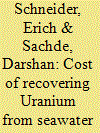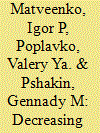|
|
|
Sort Order |
|
|
|
Items / Page
|
|
|
|
|
|
|
| Srl | Item |
| 1 |
ID:
124855


|
|
|
|
|
| Publication |
2013.
|
| Summary/Abstract |
This article develops a mathematical modeling framework using fault trees and Poisson processes for analyzing the risks of inadvertent nuclear war from U.S. or Russian misinterpretation of false alarms in early warning systems, and for assessing the potential value of options to reduce the risks of inadvertent nuclear war. The model also uses publicly available information on early warning systems, near-miss incidents, and other factors to estimate probabilities of a U.S.-Russia crisis, the rates of false alarms, and the probabilities that leaders will launch missiles in response to a false alarm. The article discusses results, uncertainties, limitations, and policy implications.
|
|
|
|
|
|
|
|
|
|
|
|
|
|
|
|
| 2 |
ID:
124853


|
|
|
|
|
| Publication |
2013.
|
| Summary/Abstract |
The uranium-235 content of a uranium enrichment plant's product is related to the uranium-234 content of its waste, allowing one to check with tails measurements consistency with a plant's declared past production. Verification works best with known feed material, but with unknown feed isotopics the production of low and high enriched uranium may still be distinguished based on tails measurements. Estimating product masses is harder, and concealment scenarios are discussed. With traditional nuclear accounting, relationships between product and waste isotopics, or "nuclear archaeology," can increase confidence in the accuracy of declarations of past fissile material production.
|
|
|
|
|
|
|
|
|
|
|
|
|
|
|
|
| 3 |
ID:
124857


|
|
|
|
|
| Publication |
2013.
|
| Summary/Abstract |
This article provides an independent cost estimate for uranium production from seawater through the braid-type adsorbent recovery system proposed by the Japan Atomic Energy Agency (JAEA). Production costs were developed with standard engineering cost estimation techniques using vendor data and plant design and operational data. The analysis includes life cycle discounted cash flows, economies of scale, and propagation of uncertainties. A reference case based on the Japan Atomic Energy Agency assessment, with a fresh adsorbent capacity of 2 kgU/t ads and 6 recycles, yielded a production cost of $1230/kg uranium with a 95 percent confidence interval of [$1030/kg U, $1430/kg U] when component cost uncertainties alone were considered. Sensitivity studies confirmed that adsorbent capacity, number of recycles, and capacity degradation are major cost drivers. If capacity and number of recycles increases to 6 kg U/t ads and 20, respectively, with no degradation and unchanged adsorbent production costs, the uranium production cost drops to $299/kg U.
|
|
|
|
|
|
|
|
|
|
|
|
|
|
|
|
| 4 |
ID:
124861


|
|
|
|
|
| Publication |
2013.
|
| Summary/Abstract |
One legacy of the Soviet nuclear program is great quantities of high enriched uranium (HEU) that were used in different research programs. The Institute of Physics and Power Engineering (IPPE), founded in 1946, was (and still is) actively involved in nuclear energy development and application, including fast breeder, naval propulsion and space power reactors. IPPE built a special experimental complex containing critical assemblies and research reactors. During 50 years of research activities, a great quantity of HEU fuel was accumulated. Some of the HEU is still used in critical assemblies, notably BFS (Fast Physical Stand) and a considerable amount of material remains in storage. Some HEU has been shipped off for blend-down and some could be used to fabricate new fuel with reduced enrichment levels. This article describes the issues related to reducing the use of HEU in IPPE research facilities-especially for the BFS critical assemblies.
|
|
|
|
|
|
|
|
|
|
|
|
|
|
|
|
| 5 |
ID:
124854


|
|
|
|
|
| Publication |
2013.
|
| Summary/Abstract |
Scientists have, within the frame of the Conference on Disarmament, been successfully engaged in support of the Comprehensive Nuclear Test Ban Treaty (CTBT) for many decades, starting long before negotiations began. This article proposes an International Scientific Network (ISN) to engage the global scientific community to explore how scientific and technological developments can support nuclear disarmament and non-proliferation. It reviews the experience gained from scientific work on the CTBT and identifies a broad range of science and technologies that might be the focus of an ISN. A key question is how such an international scientific cooperation can be created in the absence of an existing established political or managerial framework.
|
|
|
|
|
|
|
|
|
|
|
|
|
|
|
|
| 6 |
ID:
124850


|
|
|
|
|
| Publication |
2013.
|
| Summary/Abstract |
This article investigates the possibility presented by De Geer (2012) that radionuclides detected at stations in South Korea, Japan, and Russia in May 2010 were evidence that North Korea conducted at least one unannounced low yield nuclear test on 11 May. It provides HYSPLIT (Hybrid Single Particle Lagrangian Integrated Trajectory Model) atmospheric transport modeling of the observed radionuclides assuming candidate origins in North Korea, ROK, Japan, Russia, mainland China, and Taiwan. Xenon activity calculations for reactor- and explosion-produced isotopes are used to ascertain possible release ratios and source terms. The HYSPLIT modeling finds that the most likely origin of the radionuclides is close to the site of North Korea's declared nuclear tests in 2006 and 2009. The activity calculations show that the source term is consistent with a nuclear test up to a few hundred tons yield. These results are discussed in the context of a decoupled but uncontained nuclear test by North Korea on 11 May 2010. If the scenario suggested by De Geer and supported here is correct, it seems that there is a significant possibility of detecting even a small, decoupled nuclear test in North East Asia using components of the International Monitoring System of the Comprehensive Test Ban Treaty.
|
|
|
|
|
|
|
|
|
|
|
|
|
|
|
|
| 7 |
ID:
124851


|
|
|
|
|
| Publication |
2013.
|
| Summary/Abstract |
The United States produced about 2 tons of uranium-233, a weapons-useable fissile material, as part of its military and civilian nuclear program. Of that, 1.55 tons was separated at costs estimated to be between $5.5 and $11 billion. Of the 1.55 tons, approximately 96 kg of uranium-233 may be unaccounted for. There are also varying site-specific estimates suggesting that material control and accountability of the U.S. uranium-233 inventory needs to be more stringent. About 428 kg of uranium-233 is stored at the Oak Ridge National Laboratory (ORNL), in Tennessee at Building 3019, a 69-year-old structure which DOE describes as the "oldest operating nuclear facility in the World" and one that does not meet current safeguards and security requirements.
Currently, the U.S. Department of Energy's (DOE) goal for disposition of the 428 kg is 2018, more than 20 years after significant environmental, safety, and security vulnerabilities were first officially acknowledged. To meet this goal, DOE plans to waive its own waste acceptance criteria to allow direct shallow land disposal of a large portion of the uranium-233 by August 2014. Granting a disposal waiver sets a bad precedent for international safeguards and standards for the disposal of reprocessed wastes containing high concentrations of fissile materials.
|
|
|
|
|
|
|
|
|
|
|
|
|
|
|
|
| 8 |
ID:
124859


|
|
|
|
|
| Publication |
2013.
|
| Summary/Abstract |
Concerns about potential shortage of natural uranium and its increased cost, as well as the accumulation of stocks of regenerated uranium, created interest in using regenerated uranium in the process of manufacturing fuel assemblies for power reactors. However, using regenerated uranium in the fuel manufacturing process presents significant challenges from the radiation safety point of view, as this uranium contains radioactive isotopes associated with uranium-232. To explore the possibility of using regenerated uranium in the fuel manufacturing process, the Electrostal Machine-Building Plant explored the possibility of using uranium with uranium-232 concentrations of up to 5 ppb. The results of the pilot project suggest that large-scale production of reactor fuel from uranium with high concentrations of uranium-232 would require a substantial change of the technological processes and procedures for storage and handling and storage of the fuel produced with this uranium.
|
|
|
|
|
|
|
|
|
|
|
|
|
|
|
|
| 9 |
ID:
124862


|
|
|
|
|
| Publication |
2013.
|
| Summary/Abstract |
The mobile ICBM displayed in Pyongyang last April is analyzed in light of North Korea's known and reasonably suspected capabilities in the field, particularly those demonstrated in the recent and successful Unha-3 launch. Several possible configurations for the "KN-08" missile are given, and performance estimates are presented. While the displayed missiles are clearly mock-ups, they are consistent with an ongoing development program for a missile with limited intercontinental capability using only existing North Korean technology. The lack of flight testing strongly suggests that operational deployment is still months or years in the future, though an initial test could come at any time. Even with a successful test program, any such North Korean ICBM would likely be unreliable, limited in mobility and performance, and available only in small numbers.
|
|
|
|
|
|
|
|
|
|
|
|
|
|
|
|
| 10 |
ID:
124858


|
|
|
|
|
| Publication |
2013.
|
| Summary/Abstract |
Russia has given priority to nuclear power in its long-term strategy to increase its electricity generation capacity. But the sustainability of this strategy over the long term depends on the ability to solve problems associated with the production of increasing amounts of spent nuclear fuel. Rosatom,1 Russia's nuclear industrial corporation, believes that development of fast neutron plutonium-breeder reactors and their fuel-cycle technologies is the solution to this problem. This article is a review of current governmental programs associated with development of nuclear power in Russia and spent fuel management.
|
|
|
|
|
|
|
|
|
|
|
|
|
|
|
|
|
|
|
|
|